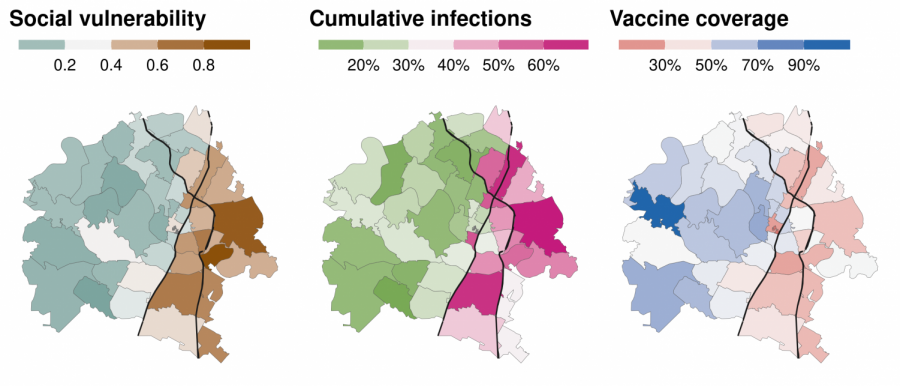UT-Austin researchers find COVID-19 has disproportionately impacted Austin’s most vulnerable
April 27, 2021
Editor’s Note: This article first appeared in the April 23 issue of The Daily Texan.
Austin’s most vulnerable communities have been disproportionately impacted by COVID-19, according to a report published by the UT COVID-19 Modeling Consortium on April 12.
Nearly 51% of Travis County’s eligible population has received at least one dose of a COVID-19 vaccine as of Thursday, according to data from the Texas Department of State Health Services. However, the consortium’s spatial distribution of COVID-19 infections and vaccinations report found significant differences in the geographic distribution of both infection and vaccination rates across the city through early April.
ZIP codes in West Austin had lower infection rates and higher vaccination rates, while those in East Austin had higher infection rates and lower vaccination rates, according to the report. East Austin is historically where lower-income communities of color have resided in the city.
These findings are highly correlated with the Centers for Disease Control and Prevention’s Social Vulnerability Index, which uses census data to rank geographic areas based on 15 social factors, including poverty, lack of transportation and housing congestion, said Spencer Woody, a report co-author and postdoctoral fellow with the consortium.
At the time of the report’s release, areas in Austin with higher social vulnerability had more infection and less vaccine coverage, said Maureen Johnson-León, a report co-author and a data equity specialist with the consortium. Even though the report focuses on Austin, Johnson-León said infectious diseases disproportionately impact communities with lower resources across the globe.
Woody said the report is intended to provide a real-time visualization to city and state officials about how efforts to address disparities are working so far.
The city of Austin is working with faith-based and other community organizations to address the disparities through outreach, Matt Lara, Austin Public Health spokesperson, said in an email. The city has also placed vaccine sites in the Eastern Crescent area, which has historically lacked routine access to health care infrastructure, Lara said.
“Social vulnerability is basically a composite metric of all of the things that have been observed in the Eastern Crescent for a long time,” Johnson-León said. “Vaccines (are) just one part of one part of the issue.”
UT’s School of Nursing recently launched two programs to address vaccine disparities in underserved communities in Austin.
Karen Johnson, an associate professor in the School of Nursing, said the school’s Vaccine Administration Mobile Operations are collecting survey data at their sites to better understand the barriers people in these communities are facing.
“We’re at a point where we have a lot of vaccines, and we’re able to give them out.” Woody said. “We want to make sure that these vaccines are being administered equitably.”
Editor’s Note: This story has been corrected to reflect that Karen Johnson is not a co-author of the report. The Texan regrets this error.



